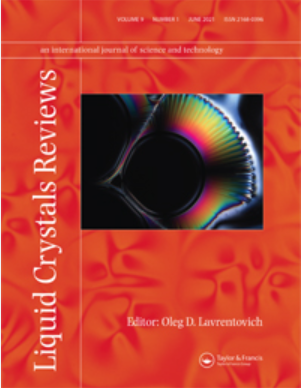氢键在树枝状结构超分子组装体介晶行为中的作用
IF 4.2
3区 材料科学
Q2 CHEMISTRY, PHYSICAL
引用次数: 8
摘要
摘要树枝状聚合物是一种人造化合物,具有独特的重复支化结构,其灵感来源于树木中遇到的各种图案。它们被认为是继线性、交联和支链聚合物之后的第四大分子结构类别。关于液晶相的形成,它们遵循与所有其他类别相同的规则。适当的化学官能化可诱导偏析。二次相互作用,特别是氢键形式的相互作用,通过调节极性波动和其他性质(如刚性),在中间相的形成中也起着至关重要的作用。因此,在一些情况下,液晶性完全归因于氢键网络的存在,而在更多的例子中,中间相的形成主要是由于这些相互作用而诱导的。综述了分子内键和分子间键对树枝状聚合物液晶特性的影响。这篇综述还涵盖了一些超分子组装体的例子,这些超分子组装体表现出结构或结合了让人想起树的元素,而树不能被归类为树枝状聚合物,其中由氢键引起的偏析由相同的原理控制。同时,还描述了观察到的与不同氢键模式相关的各种中间相,并提出了一些一般结论和规则。本文章由计算机程序翻译,如有差异,请以英文原文为准。
The role of hydrogen bonds in the mesomorphic behaviour of supramolecular assemblies organized in dendritic architectures
ABSTRACT Dendritic polymers are artificial compounds with a unique, repeatedly branched structure inspired by the respective patterns, encountered in trees. They are recognized as the fourth major macromolecular architectural class next to linear, cross linked and branched polymers. Regarding the formation of liquid crystalline phases, they follow the same rules as all the other categories. Suitable chemical functionalization induces segregation. Secondary interactions, in the form of hydrogen bonds in particular, also play a crucial role in mesophase formation by regulating polarity fluctuations and other properties such as rigidity. As a consequence, there are some cases where liquid crystallinity is attributed exclusively to the presence of hydrogen bonding networks, whereas in many more examples mesophase formation is induced mainly due to these interactions. A survey of intra and intermolecular bond influence on the liquid crystalline character of dendritic polymers is presented. The review also covers some examples of supramolecular assemblies exhibiting architecture or incorporating elements reminiscent of trees which cannot be classified as dendritic polymers where segregation resulting by hydrogen bonding is governed by the same principles. In parallel, a description of the various mesophases observed in correlation to different hydrogen bonding patterns is included, and some general conclusions and rules are suggested.
求助全文
通过发布文献求助,成功后即可免费获取论文全文。
去求助
来源期刊

Liquid Crystals Reviews
CHEMISTRY, PHYSICALCRYSTALLOGRAPHY&n-CRYSTALLOGRAPHY
CiteScore
7.60
自引率
5.90%
发文量
8
期刊介绍:
Liquid Crystals Reviews publishes review articles on all aspects of liquid crystal fundamentals and applied science, including experimental and theoretical studies of physical and chemical properties, molecular design and synthesis and engineering of liquid crystal devices. The Journal fosters cross-disciplinary exchange of ideas, encouraging authors to present material at a level accessible to specialists from other fields of science and engineering. Liquid Crystals Reviews provides the scientific community, in both academia and industry, with a publication of standing, guaranteed by the Editors and by the International Editorial Board who are active scientists in the worldwide liquid crystal community.
 求助内容:
求助内容: 应助结果提醒方式:
应助结果提醒方式:


